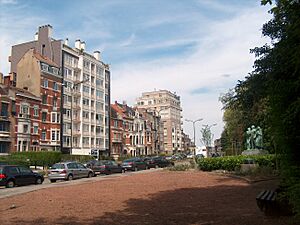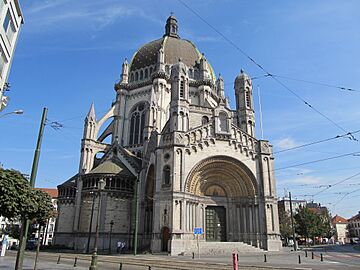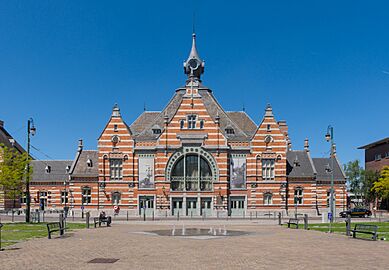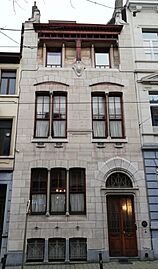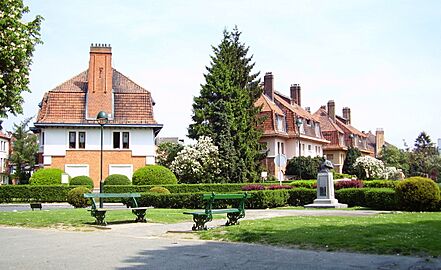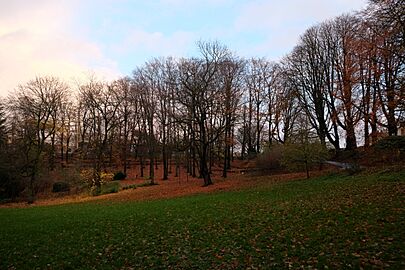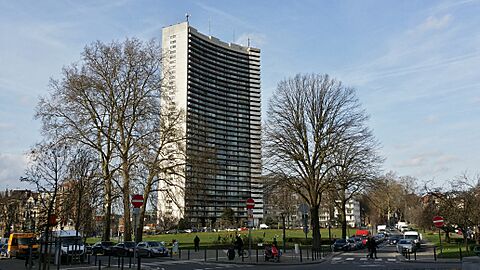Schaerbeek facts for kids
Quick facts for kids
Schaerbeek
|
|||
|---|---|---|---|

Schaerbeek's Municipal Hall seen from the Place Colignon/Colignonplein
|
|||
|
|||
| Country | Belgium | ||
| Community | Flemish Community French Community |
||
| Region | Brussels | ||
| Arrondissement | Brussels-Capital | ||
| Area | |||
| • Total | 8.14 km2 (3.14 sq mi) | ||
| Population
(2018-01-01)Lua error in Module:Wd at line 1575: attempt to index field 'wikibase' (a nil value).
|
|||
| • Total | Lua error in Module:Wd at line 1,575: attempt to index field 'wikibase' (a nil value). | ||
| Postal codes |
1030
|
||
| Area codes | 02 | ||
| Website | 1030.be/fr 1030.be/nl |
||
Schaerbeek (in French) or Schaarbeek (in Dutch) is one of the 19 towns in the Brussels-Capital Region in Belgium. It is located in the northeastern part of the region. Schaerbeek shares borders with the City of Brussels, Etterbeek, Evere, and Saint-Josse-ten-Noode. Like all towns in Brussels, it is officially bilingual, meaning both French and Dutch are spoken.
Schaerbeek is known for its diverse population, which gives it a rich multicultural feel. As of 2022, about 130,690 people lived there. The town covers an area of 7.9 square kilometers (about 3 square miles). This means it has a high population density, with many people living close together.
Contents
What's in a Name?
How Schaerbeek Got Its Name
The name Schaerbeek first appeared in a document from 1120. It was written as Scarenbecca. The name likely comes from old Franconian words. These words are schaer, meaning "notch" or "score," and beek, meaning "creek" or "stream."
Schaerbeek is also called "the city of donkeys." In the past, people from Schaerbeek grew many sour cherries. They used these cherries to make a special beer called Kriek lambic. Farmers would bring their cherries to the Brussels market on donkeys. Today, you can still see donkeys in Josaphat Park. Sour cherry trees also grow along streets in the Diamant Quarter of Schaerbeek. These streets include Avenue Milcamps, Avenue Émile Max, and Avenue Opale. There's even a place called Square des Griottiers, named after these cherry trees.
A Look Back in Time
Early Days and Middle Ages
People have lived in the Schaerbeek area for a very long time. Stone Age tools have been found in the Josaphat valley. Roman tombs and coins from the 2nd century AD were also discovered. These finds were near old Roman roads that crossed Schaerbeek.
The town's name was first mentioned in 1120. This was in a legal paper where the Bishop of Cambrai gave control of churches in Scarenbecca and Everna (now Evere) to priests in Soignies. Schaerbeek was part of the Duchy of Brabant. In 1301, the Duke of Brabant decided that Brussels' aldermen would manage the town. A new church, dedicated to Saint Servatius, was built around this time.
By the late 1300s, some lands in Schaerbeek became a hunting ground. Important visitors, like the Dukes of Burgundy, would enter Brussels through Schaerbeek. The town kept its rural feel and hunting areas until the late 1700s. People also grew vegetables and grapes. In 1540, Schaerbeek had 112 houses and 600 residents.
From the 1500s to the 1800s
Schaerbeek was mostly peaceful until the 1500s. But then, the Protestant Reformation brought many conflicts. Over the next two centuries, Schaerbeek suffered damage and destruction many times. Different armies, including Spanish, French, British, and Bavarian troops, passed through. They often took supplies and caused trouble for the people.
After the French Revolution, Schaerbeek became its own independent town. It had its own mayor and local government. In 1830, during the Belgian Revolution, there was some fighting in the Josaphat valley. This was between revolutionary troops and Dutch soldiers. Later, a more modern Church of St. Servatius was built in 1879. The old church was taken down in 1905. The Municipal Hall was built in 1887, and the railway station in 1902.
In the late 1800s and early 1900s, Schaerbeek became a popular place for wealthy families. New tree-lined streets, like Avenue Louis Bertrand, were created. Many middle-class families moved here. They hired famous architects like Gustave Strauven, Franz Hemelsoet, and Henri Jacobs. These architects designed beautiful homes and buildings in the Art Nouveau style.
The 1900s and Today
At the start of the 20th century, Schaerbeek was a fast-growing suburb. It attracted many middle-class residents. In 1904, the new Josaphat Park was opened. A year later, the old St. Servatius' Church, a link to Schaerbeek's medieval past, was removed. During World War I, in 1915, a British nurse named Edith Cavell was executed by German soldiers at the Tir national (a shooting range). After World War II, Dwight D. Eisenhower visited the town. Five years later, Schaerbeek's population reached its highest point, with 125,000 people.
Parts of Schaerbeek
Schaerbeek has two main areas: an eastern part and a western part.
The eastern part is a wealthier area. It includes places like Square Vergote, Boulevard Lambermont, the Fleurs Quarter, Place de Jamblinne de Meux, the Diamant Quarter, and Josaphat Park. This area is known for its beautiful buildings. It is also close to important places like the EU institutions and NATO's headquarters.
The western part of Schaerbeek is near Brussels-North railway station. This area is home to many different communities. It has a large Belgian Turkish community. The area around St. Mary's Royal Church is even called "Little Anatolia." This is because of all the Turkish restaurants and shops on the Chaussée de Haecht. There are also many Belgian Moroccan people and other immigrant groups, such as Spanish, Congolese, and Asian communities. This part of town is also home to many schools and local government offices.
Who Lives in Schaerbeek?
Schaerbeek has a large number of people from other countries and their children. Many people have Turkish family roots, often from places like Afyon or Emirdağ in Turkey.
Like some other towns in Brussels, Schaerbeek has a large Muslim population. In 2016, most Muslims in Schaerbeek were of Moroccan origin. There were also many Turkish and Albanian people. The mayor of Schaerbeek, Bernard Clerfayt, has said that this mix of different groups helps prevent any one group from being isolated.
As of 2023, about 52.78% of Schaerbeek's population comes from non-European countries. These are mainly from Morocco and Turkey. Another 21.13% are from other European countries, such as Bulgaria, Romania, France, Spain, and Poland. The remaining 18.46% are native Belgian people.
Here are some of the largest groups of people from other countries living in Schaerbeek as of January 1, 2020:
| 5,728 | |
| 5,072 | |
| 4,463 | |
| 4,275 | |
| 3,266 | |
| 3,041 | |
| 2,781 | |
| 2,850 | |
| 1,754 | |
| 1,435 | |
| 1,325 |
Schools in Schaerbeek
Schaerbeek has several schools for different age groups.
Public French-language secondary schools include:
- Athénée communal Fernand Blum
- Institut communal d'enseignement technique Frans Fischer
- Lycée Emile Max
French-language religious secondary schools include:
- Institut Sainte-Marie (Schaerbeek)
- Collège Roi Baudouin
- Institut de la Saint-Famille d'Helmet
- Collège Roi Baudouin Enseignement technique et professionnel
- Institut Technique Cardinal Mercié-Notre-Dame du Sacré-Coeur
- Institut Saint-Dominique
- Institut de la Vierge Fidèle
For Dutch speakers, Koninklijk Atheneum Emmanuel Hiel is the public secondary school. It is run by the Flemish Community.
Places to See
- Schaerbeek has many beautiful Art Deco and Art Nouveau buildings. One famous example is the Autrique House. This was the first house built by the famous architect Victor Horta in Brussels.
- The Schaerbeek Municipal Hall is a grand building. It was designed in a style called neo-Flemish Renaissance. King Leopold II opened it in 1887.
- Josaphat Park is a peaceful green space in the city. King Leopold II also opened this park in 1904. Next to the park is the Brusilia Residence, which is the tallest residential building in Belgium.
- Schaerbeek railway station is home to the new national railway museum of Belgium, called Train World. It opened in 2015.
- Saint Mary's Royal Church is a large Catholic church. It was built between 1845 and 1888. It has a mix of different architectural styles and has been a protected building since 1976.
- You can also visit the Clockarium, a museum dedicated to clocks. Nearby, there is a beer museum and a mechanical organ museum.
The Schaerbeek Cemetery, despite its name, is actually located in the nearby town of Evere.
Famous People from Schaerbeek
- Jacques Brel (1929–1978), a famous singer-songwriter and actor.
- Nicolas Colsaerts (born 1982), a professional golfer.
- Michel de Ghelderode (1898–1962), a playwright who worked at the Municipal Hall.
- Andrée de Jongh (1916–2007), a member of the Resistance during World War II.
- Paul Deschanel (1855–1922), a French statesman and former President of France.
- Virginie Efira (born 1977), an actress and TV presenter.
- Georges Grun (born 1962), a football player.
- Henri Jacobs (1864–1935), an Art Nouveau architect.
- Camille Jenatzy (1868–1913), a racing driver.
- René Magritte (1898–1967), a famous surrealist painter.
- Maurane (1960–2018), a singer and actress.
- Jean Roba (1930–2006), a comic book author who created Boule et Bill.
- François Schuiten (born 1956), a comic book artist.
- Paul-Henri Spaak (1899–1972), a politician who was Prime Minister of Belgium and a founder of the European Union.
- Gustave Strauven (1878–1919), an Art Nouveau architect.
Schaerbeek Around the World
Schaerbeek has "twin town" relationships with several places around the world. This means they share cultural ties and friendly connections.
Twin Towns and Sister Cities
Schaerbeek is twinned with:
 Houffalize, Belgium
Houffalize, Belgium Al-Hoceima, Morocco
Al-Hoceima, Morocco Nablus, Palestine
Nablus, Palestine Beyoğlu, Turkey
Beyoğlu, Turkey Prairie Village, Kansas, United States
Prairie Village, Kansas, United States Dardania, Pristina, Kosovo
Dardania, Pristina, Kosovo Quebec City, Canada
Quebec City, Canada Vicovu de Sus, Romania
Vicovu de Sus, Romania Anyang, China
Anyang, China
See also
 In Spanish: Schaerbeek para niños
In Spanish: Schaerbeek para niños






